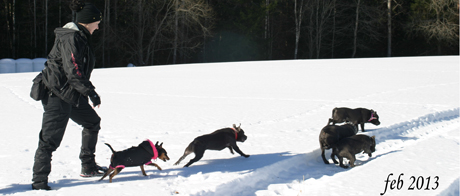


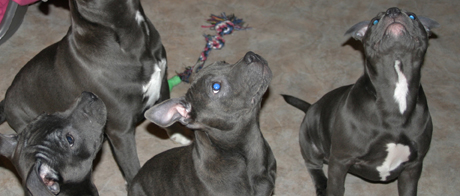

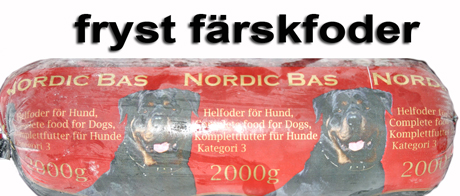



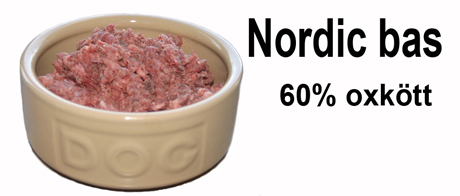

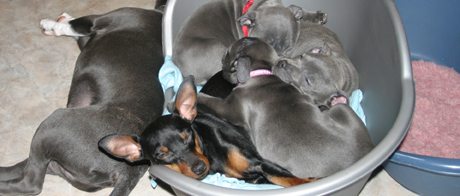
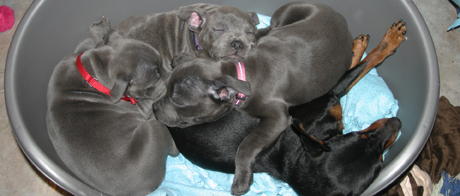
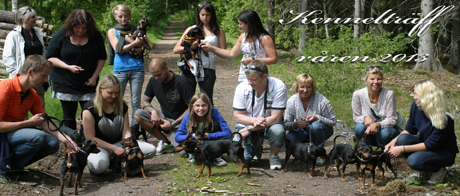
Health and Tests
Staffordshire Bullterrier.
Before bying a puppy!!!
I think it's important to know about all the health issus that is or may become a problem for a staff before bying a pup if the parents aren't tested.
Dogs are like humans no one is without flaws. The difference is that in the dogworld the human often decides the parents for the puppys that's why I think it's good to know what to look out for before buing a pup. There are serious and also unserious breeders out there. Many breeders are very responsible and do everything they can to avoid breeding dogs which have or carry an inherited disease. I have posted information on many diseases and it's not that everyone is most common in just the Staffy, many are common in other breeds as well. I have not written about them either due to that Staffies are in the highest risk of getting the diseases, but informative to you who are considering a staffie or have one, so here are more comprehensive information than you will find at any other kennel page. I have read much on the many sides of all diseases and compiled material. The research makes progress every day, but you should keep in mind that research is carried out only where there is money to be gained. Initially, it can be said that this is primarily for curing diseases in humans, in the end, it may also benefit the dog. If You find other supplementary materials or errors, please email me. English isn't my native language and I would appreciate if You would let me know about my translation. I'm a bit of perfectionist.
"I am not a veterinary or a Proffessor, if so, I would get paid for my opinions and then they would not be objective. I am a reader and interested of statistics, performed studies, not only for my own breed. I am open minded, always comparing, analyzing, responsible and objective. I hope to inspire by gathering the information available.
I would be amazingly happy if you send me links with
information that complements or foil my material".
A common goal for Swedish breeders are producing dogs of good quality. The meaning varies because it depends on the breeder's main area of interest e.g. hunting , exhibition , and that few have actually formulated a clear meaning of the concept of quality. The general definition meant by quality is: What you expect and the quality you experience. One way to get consistency between expectations and experience can be Swedish RAS = Swedish breedclub specific breeding strategies. Which is a worked out Breed description with adequate information on the breed's characteristics, advantages and disadvantages, strengths and weaknesses .
RAS ( Specific breeding strategy for Staffordshire Bullterrier )addressed to the breeders as a means to improve the quality of the breed. By tradition, we usually divide the dog's characteristics in exterior, function, mental qualities, health and illness. In Sweden we have something unique with open registers and the ability to facilitate breeding planning by the Swedish Kennel Club breeding data. The only genes that man in breeding have full control over are those that are measured , recorded, and that really is the basis for breeding selection. If you try to make too many improvements at once existing each mating will on average not achieve any success at all.
My view of the current Breeding Staffordshire Bull Terrier:
The Staffy have a variety of reasons more health problems than if I compare with my other breed eg miniature pinscher. The goal should always be to breed healthy, mentally stable dogs , with an appearance typical for the breed. In order to breed out the health problems found in the Staffy I don't feel that it should be introduced limits on breeding through testing, for it would at present be able to make breeding base too tight and then maybe such a mentally nicer dog would be weeded out from the breed which with a good planned breeding strategy could be addressed in the next stage.
That we breeders together take responsibility and do the health tests available. Evidently , many of the diseases is hereditary. Our use of the test results to see the whole picture together in the future to be able to breed a healthier staffy. By testing , we can try to avoid mating dogs with the same defects.
BREEDING SUCCESS, we get by using the tests as a tool for selection of breeding animals .
-What does The Swedish Kennel Club and the Swedish law say?
Under the law, no dogs and cats should be used for breeding if :
- They have an illness or a disability that can be inherited.
- They have or are likely to have recessive gene in duplicate for disease.
- They have or are likely to have simple recessive gene for disease unless mating occurs with individuals who are found free of the corresponding genes.
- Mating combination on the basis of available information increases the risk of illness or disability in the offspring.
According to the Swedish Kennel Club ground rules should dog breeding be..."conducted in a manner that promotes the offspring's health and wellbeing". It is also a requirement that the breed
"use dogs that do not have serious illness / disability " and that " in breeding avoid mating combination that based on available information increases the risk of serious illness / disability in the offspring. "
My breeding Goals
Try to bring one or two improvements regarding every mating, that benefit the breed.
Briefly about genetics
Dogs can suffer from many diseases and many of these can be inherited. Pedigree breeding and an appearance typical for the breed has made many breeds reared separately for many years. One result of this is not only their likeness in appearance but also increases the likelihood that they develop particular diseases. Research has shown that every well studied breed is prone to a number of diseases.
Why is it then that some breeds have more diseases than others?
-Well, all dogs within a specific breed is sired by a limited number of original dogs.
- Matador Breeding - The individuals used too frequently. A few such stud males perceived breed typical, or with speciellay good qualities as e.g hunting , mentality, exterior, health status.
- Small populations , Animal Breeding. The smaller the farmer uses maybe a few individuals in the breed.
- Inbreeding - The average relatedness increases. Made either to create more similar individuals or simply for breeding base is too small.
- Line Breeding - Try to preserve or recreate unique pieces such progenitor / stem mother. Working on breeding copies of this individual. Species that is very closely related to this , any offspring in the first or the second part , but also individuals who are relatives at a distance.
I think that knowledge of genetics is exciting and is not really necessary for the smaller breeder , but for those who really want to understand genetics can be a great help in the selection of breeding animals, and to understand the tex Swedish Kennel Club and breed clubs DEVICES purposes with genetic health . It may have taken a hundred years of work for generations of interested dog breeders to create a race with a special appearance and a specific use. This is worth respecting. This is done by not bringing further defects that causes either the dog or the owner suffering. In the wild, however, as for example the wolf's survival is the ability to survival passed on to the next generation.
Genetics and inbreeding coefficient: In the simplest form, one can say that every puppy will inherit 50% of the father's genes and 50% of the mother's genes. This is the only absolute kinship degree all the others are likely averages. Two full siblings also share on average 50% of their genes , thanks to his relationship , but they can theoretically inherit completely different genes from the father and mother and to be completely unrelated to each other. I have my own example from mating between two of my miniature pinschers who both had fine saber tails and half of the puppies got twist tail. This was a visible gene came from the former part of any of their inheritance. That brings me to the genes that can not be seen or hidden recessive trait. Many diseases / defects are inherited in this way that we can not see them. The dog wears the predisposition for a disease without itself being affected by it. Some defects / diseases do not develop until the disease genes hits to the corresponding genes for the same defect. It is this that makes dog breeding so precarious. Dominant trait like colour is much easier to predict.
So how do you know if your dog carries a defective gene?
- By testing your dog for the diseases that are a problem in your breed .
First, a brief description of available tests for the staffy,
then a more detailed about each.
In order to mate clever, both parents need to be tested.
DNA Tests:
L2-Hga: Neurological disease
HC och HSF4: Hereditary Eye catatacts
Manuella Tester:
Ögonlysning: Eye exam made by a spec. vet
Patella: Knee examination
Röntgen Tester:
HD: Hip X-ray
AD eller ED: Elbow X-ray
MH och BPH: Mentaltests
A more detailed description about diseases, tests, treatments and breedingadvices
then a more detailed about each.
In order to mate clever, both parents need to be tested.
L2-Hga: Neurological disease
HC och HSF4: Hereditary Eye catatacts
Manuella Tester:
Ögonlysning: Eye exam made by a spec. vet
Patella: Knee examination
HD: Hip X-ray
AD eller ED: Elbow X-ray
MH och BPH: Mentaltests
A more detailed description about diseases, tests, treatments and breedingadvices
L2-Hga: is a breed Specific disease staffys are manifested by difficulty coordinating movements, loss of obedience and housetraining, nervous condition, tremors, muscle stiffness, seizures, etc. It is rare that the disease breaks out when it is required that both the bitch and the male has a predisposition to the disease. Therefore it is important that breeders ensure that ignorance or unwillingness to test the danger of pairing two carriers of the disease.
There is a simple DNA test should be done before any breeding, if you do not have papers on that bitch and male parents are tested. The result you get is the following:
"Clear" - The dog is not a carrier of the disease.
"Carrier" - The dog carries genes for the disease but will not itself become ill.
"Affected" - The dog carries twice predisposition to the disease and will therefore fall ill.
The disease is inherited in the following manner:
Clear x Clear = All pups become Clear
Clear x Carrier = Half become Clear, half become Carrier
Clear x Affected = All pups become Carrier
Carrier x Carrier = 25% Clear 25% Affected 50% Carrier
Carrier x Affected = Half Affected, half Carrier
Affected x Affected = All pups become Affected.
Treatments and Symptoms: From what I've read epilepsy seems to be what affects these dogs most commonly and it starts with a milder degree. There are also humans that have this disease. It is a terrible disease to live with. Most seem to agree on short exercise and playtime with his dog. In the U.K, the vets is more aware of how it really works for the dog to live with, and they have become much more skilled than we seem to be in Sweden to test for the disease. In the U.K, they have taken the disease seriously and matings seem to be made only with dogs that are Cleared. In Sweden, one often sees that you mate a clear with a carrier. There are also matings made with completely untested dogs. A carrier is only a dog that the disease does not appear on, so chances are really that mating is done with another carrier.
Here you can get in touch with others who have dogs with the disease:
www.willowstaffie
"Breeding and development of breeds should be targeted, long-term and sustainable. Sustainable means that it does not lead to deficiencies in health, mentality, function, or gives the breed genetic variation. Breeding and rearing must also be in compliance with animal welfare legislation and Swedish Kennel Club's ground rules . dogs with serious illness / disability should not be used for breeding. mating Combination basis of available information increases the risk of serious illness / disability of the offspring should be avoided. "//Extract from the Swedish Kennel Club's breeding policy.
My view of breeding: If You can read the posts in willowstaffie without tears? Then buy a puppy whose parents are not tested. If you meant to just have it as a pet, then you can buy a carrier.
Unfortunately there is no central record of the results of these health tests, so you have to ask yourself the breeder show on paper by previous DNA test.

HC and HSF4: Heriditary Cataract. There are a numerous amount of eyediseases where some are hereditary. One of those is Cataract which is a deases that leads to total blindness. The disease is inherited in the same manner as L2-Hga and a smilar DNA-test is available to test the dog. Hereditary Cataract in Staffordshire Bull Terriers has been recognised as an inherited condition since the late 1970's. Affected dogs develop cataracts in both eyes at an early age. The condition is not congenital, so the lenses are normal at birth but cataracts appear at a few weeks to months in age, progressing to total cataract (and resulting blindness) by 2 to 3 years of age.
The lens of an eye is usually clear and focuses light on to the retina. A cataract is an opacity (cloudiness) in the lens, usually white, which scatters the light. The level of impact on vision can vary according to the size of the cataract (varying from a pinhead to the total lens) and its location on the lens.
To explain this a little further, a brief look at lens anatomy is needed. The lens consists of a core, called the nucleus, surrounded by an outer layer called the cortex, coated with a thin layer of cells around the whole lens called the capsule. The front surface of lens (closest to the outside of the eye) is called the anterior surface. The back surface (closest to the inner part of the eye) is the posterior surface.
One HSF4 mutation causes the recessive form of Hereditary Cataracts in Staffordshire Bull Terriers. Because it is recessive, a dog must have two copies of this mutation to experience this form of cataracts. This mutation is only responsible for early-onset hereditary cataracts, which typically occur between 12 months and 3 years of age in Staffordshires.
The disease is inherited in the same way as for L2-Hga:
"Clear" - The dog is not a carrier of the disease.
"Carrier" - The dog carries genes for the disease but will not itself become ill.
"Affected" - The dog carries twice predisposition to the disease and will therefore fall ill.
The disease is inherited in the following manner :
Clear x Clear = All pups become Clear
Clear x Carrier = 50% becomes Clear, 50 % becomes Carrier
Clear x Affected = All pups become Carrier
Carrier x Carrier = 25% Clear 25% Affected 50% Carrier
Affected x Affected = Alla pups become Affected.
Unfortunately there is no central record of the results of these health tests, so you have to ask yourself the breeder show on paper by previous DNA test.
"Breeding and development of breeds should be targeted, long-term and sustainable. Sustainable means that it does not lead to deficiencies in health, mentality, function, or gives the breed genetic variation. Breeding and rearing must also be in compliance with animal welfare legislation and Swedish Kennel Club's ground rules . dogs with serious illness / disability should not be used for breeding. mating Combination basis of available information increases the risk of serious illness / disability of the offspring should be avoided. "//Extract from the Swedish Kennel Club's breeding policy.
My view of breeding: If You can lead and be a safety for your dog who is blind? Then buy a dog whose parents are not tested. If you meant to just have it as a pet, then you can buy a carrier.

Eyescreening: Made by specially trained veterinarian where one can find
Cataracts: Sick opacities in the lens, is available in both hereditary and non-hereditary form.
Gluakom: Generic name when the pressure inside the eye becomes too large. Often difficult to see at a eyecheck. Often also rapidly progress which is very painful for the dog
Progressive retinal atrophy (PRA) involves retinal atrophy. Detecteds by eyescreening and is hereditary.
Retinal dysplasia also can be detected by an eyexamination and are often no worse with the years, however, the pleats to be in varying degrees of severity, from one small wrinkle to the whole retinal loose. Most dogs can live normal lives, but if you breed two dogs with retinal dysplasia there is the risk that the puppies get severe variations of the disease.
Sweden is one of the first countries in the world that began eyescreening dogs and create genetic healthprograms of the eyes, all organized by the Swedish Kennel Club (SKK). The hereditary PRA , progressive retinal atrophy, has been discovered in a couple of different races and become a threat to the breed. Already in the sixties acquire some veterinarians trained and equipped to detect PRA and other eye diseases. Since then the business has grown . Today examines thousands of Swedish dogs each year of about thirty-five specially trained veterinarians. The majority of the surveyed dogs are breeding stock. Several breed clubs also recommend looking into other dogs at least once in life. For some breeds done in connection with hip x-ray, in other breeds , dogs should rather be middle-aged .
How is the Eyescreening performed?
Innermost Parts: Before the survey, each dog one drop in each eye of the preparation Mydriacyl ® . After that You'll have to wait about twenty miutes. The preparation widens the pupil so that specialistvet can light into the eye and investigate without the pupil contracts.
Not to bright spots in the room shall be reflected in the dog's eye made the survey always in the dark. The vet should have your back against a smooth wall without windows or other shiny surfaces such as glossy posters or glazed panels . With an indirect ophthalmoscope and a handheld lens examines know the ocular fundus , the innermost parts of the eye: the retina and optic nerve. Vet. studying retinal blood circulation and color, look for shiny or blotchy parties or patches of abnormal appearance. Examples of abnormalities in the retina might be abnormal wrinkling , scarring , detachment or early signs of a hereditary and progressive atrophy. Changes in the optic nerve is seen as part of the syndrome at some breed specific eyes errors. When the need for greater magnification to study the optic nerve is also a small hand-held instrument .
Front parts :
Another instrument that is mandatory at eyecheck called slit lamp but is actually called biomicroscope. It is a hand held microscope which makes it possible to examine living (BIOS) tissue. The instrument emits a narrow beam column and magnifies at least ten times, making it easy to identify very small changes in the anterior parts, particularly the cornea, iris and lens. Nowadays also includes assessment of the eyelids in the survey. When Vet. using the slit lamp the dog's eye to be completely still and very close. Vet. leaning cheek to cheek with the dog. Sometimes just the nearby feel intimidating. Usually for the dog and occasionally for the vet. It is not easy to read a dog's body language or facial expression in the dark. But when the growls straight into your ear you have to be on their guard.
The investigation is the same for all dogs but you will find different changes in different breeds. Most dogs who are screened have normal eyes. By screening I mean that one goes through asymptomatic individuals to find the earliest signs of hereditary eye disease .
A careful examination will find both important and unimportant changes. We can call them harmless incidental finding. A veterinary finds similar eye variations and harmless incidental findings in dogs eyes. Of middle-aged dogs have twenty percent of small opacities in the lens, cataract dots that do not lower the eyesight but may influence the choice of partner when you mate the dog. Malignant changes, those that make the dog blind or painful or both is seen only in a few percent of screened dogs.
Why Illuminating Eye ?
In our Cost - Utility computing world , one might wonder if it is worth the money and effort to look for defects that occur in low frequency. As always can reason in two ways. IF all breeders of a breed has extremely good control on which dogs are carriers , never crossing the lines and additionally limits the number of puppies after each breeding so it can work to not screening in the race. In almost all races where there are PRA and severe lens diseases is still eyecheck recommended. When the first cases were detected well tend diseases already have deep roots in the population and are scattered in many popular lines. Especially in races with few registrations and / or when some families have a major impact in the breeding and / or there is a matador or line breeding , it is important to identify the breed's genetic diseases.
- UA = Unaffected
- Affected disease, degree and hereditary or not.
The survey can be made no earlier than one year of age, and the result is official at the Swedish Kennel Club and is found under veterinary examinations.
My view of breeding: Some of these diseases are those that arise when the dog gets older. People also suffer from gray cataracts or glaucoma, and often it's a long ongoing process and heredity may often not be observed at first eyescreening until having to come back again after a year or so. Bringing a dog's eyes tested clear, does not mean it can not get a complaint at the next eyecheck. If You've done your dogs eyes checked without complaint, you have done what you can. In some breeds are eyecheck a requirement e.g within one year prior to mating.

Patella luxation: The word patella is a diminutive ("little" -) form of the Latin word patina, which means "a flat disk." The description fits the man's kneecap but less good on the dog
In the dog's patella oval in shape. It is set in large thigh muscles sinew and partly covered by it. Lower surface is easy dome shaped and has a shape such that it fits exactly in a cartilage dressed furrow between the femur roller cams. Patella slides up and down in the groove when the leg is stretched and bent
(see photos to the right).
Lateral and medial
Lateral means in this context "on the outside" and medial means "inside". At a lateral luxation patella glides over the outer roller cam and at a medial glide it over the inner. Lateral dislocation is uncommon and occurs mainly among some medium breeds, such as flat coated retriever, standard poodle and Wachtelhund.
Medial dislocation occurs almost only in dogs less than 10 kg adult weight.
Symptoms: Many dogs are completely unencumbered by their flapping kneecaps, they neither limping or in pain. Others become limp and then and the knee may lock up for a while in the flexed position. The locking can go away by itself, or the dog may need help: they bend and stretch the trail a few times until it releases. Some react with pain when you manipulate the locked knee. In the worst case, the knee is permanently locked and the dog is lame or jumping on three legs. With one in four dogs with patella luxation is the change -sided.
Wheels Bent: Kneecap incorrect location for the inside is changing forces around the knee and can cause abnormal growth in both the femur, fibula and ligaments. Looking from behind seen dog can see bowlegged out. On a radiograph is seen that legged assembly caused by the femur makes a bow outwards and fibula a bow inwards , together form an S-shape with the knee joint in the middle of the S. Joint space should normally be completely horizontal but may be incorrectly angled , and in the worst case, the entire trail also be rotated.
Puppies: Upon inspection of an eight-week puppy the veterinary goes through the little body systematically. Sometimes we find that the kneecaps feel loose at a puppy. It can be normal. Various structures are undeveloped and unstable ligaments. One can not therefore predict an adult dog's kneestatus already in puppy age , just as one can know anything about hip or elbowstatus. When the puppy grows, the immature knee getting a completely normal development and ligaments will normally austere.
No limping: Many dogs with mild patella luxation is untroubled throughout life. Perhaps the change is detected only at a control before mating. Alternatively, some being little limp during adolescence but then grows limp away. Most commonly, the dog is showing slight limp and irregular hind movement occasionally.
A dog without no symptom needs no treatment.
Dog that limps: For a dog that is often slippery and / or are short of luxationen various operations be considered. The easiest way is to tighten up the knee joint capsule with a wire that is attached to a support leg behind the knee joint so that the patella is moved back between roller chambers.
In other cases, one can have a better effect if, instead moving the thigh muscles underlying bone so that it aligns with the roller groove. In a third method immerses you roll mainstream by simply cutting out a benklyfta from the canyon bottom, take away the thinner section and then add back the cartilage -covered piece.
Breeding: The inheritance is regarded as polygenic (ie, multiple genes interact) even if there are flaws in the genetic studies regarding patella luxation. As part of the health program examines knees in breeding of certain breeds. A dog who has dislocation of the patella should not be used for breeding. Healthy siblings should be paired sparingly. If a female or male left the puppies with patella luxation in different combinations affect the dog's future breeding value. What are the rules which apply to a particular race decided by the respective breed club.
If the frequency is high in a race with few individuals can not exclude too many dogs from the breeding program at once, so you must make a plan that spans several generations. The worst are eliminated in the first stage and the requirements could increase as the breeding stock can withstand it.
Grading of patella luxation occurs on a scale from 0 to 3 and is based on the ease
with which luxe takes place:
- Grad 0 = Normal.
- Grad 1 = Patella can be luxated manually but returns spontaneously to normal mode.
- Grad 2 = Patella can easily luxated either manually or spontaneously and can remain dislocated.
- Grad 3 = Patella is permanently luxated.
The survey can be made no earlier than one year of age, and the result is officiall at the Swedish Kennel Club, (and is foundunder veterinary examinations). The survey is simple and painless for the dog. It stands on a table with the butt against the investigator. The vet grips with the fingertips around the kneecap and considers whether it can be moved out of position, first to one side and then to the other.
HD: Hip dysplasia. Means an abnormal development of the hip joint.
The X-ray shows the fit between the femoral head and femoral bowl partly on how deep the femoral head is in femoral bowl. For official assessment and registration with the Swedish Kennel Club earliest X-ray after 12 and 18 months of age depending on the breed.
Grading Hip status: Nowadays Internationally it is graded on the scale from A to E where A is the best. When talking about "normal hips" is usually meant hips with results A or B.
A dog can have different results on the right and left hip. Then forsees the worst result.
Swedish Kennel Club has stated that it is not acceptable to breed dogs that have D or E-hips with each other.
- A = Normal Hipjoint
- B = Normal Hipjoint
- C = Mild dysplasia.
- D = Moderate dysplasia.
- E = Severe dysplasia.
If there are burdening/cartilage graded it's according to how large and widespread they are.
- LBP = Mild burdenings
- MBP = Moderate burdenings
- KBP = Severe bone burdenings
- DUPLEX = Both sides.
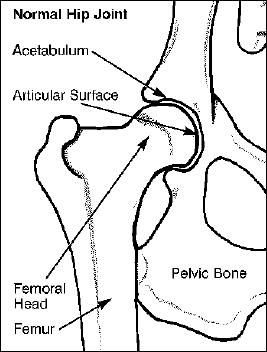
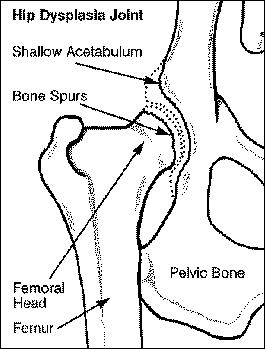
It's impossible to only by x-ray identified if a dog is suffering from its dysplasia. Uncertainties surrounding the relationship between pain and burdening are not . There are dogs who are limping and showing other signs of pain even though they only have a mild dysplasia , whereas individual dogs with severe dysplasia occurs completely symptom-free. Generally, the small breeds have less problems of hip dysplasia than larger, heavier dogs. HD sooner or later lead to a deterioration of the cartilage in the hip joint. A hip where the ball does not sit well in the hip dish will more likely result in burdening the legs. These burdening can cause pain and stiffness of the dog , especially when the dog gets older. Burdenings are increasing generally with age and sometimes leads to the hip joint becomes completely deformed at the old dog. This makes the X-ray images of old dogs with heavy burdening can not judge from a dysplasia point of view.
Causes for Hip- dysplasia
- Heritage = polygenetically (i.e multiple genes interact).
- Enviroment and Impact= excercise quantity, structure and overweight.
According to studies it's possible to prevent a dog's hip problems by keeping them slim, because obesity increases the load. Exercise them in moderation. Minimize the risk of hard exercise with sudden starts and stops and quick turns.
The history of hip- Xray:
In the sixties began some countries with breeding programs against hip dysplasia when the decade before beginning to believe that the development of the disorder was hereditary.
1974 the first gathering of F.C.I. (Fédération Cynologique Internationale ) was held in Utrecht. purpose of
the meeting was to exchange knowledge and develop a joint program that would lead each country should have at least one reader of radiographic examinations .
1981 the F.C.I. to try to agree on a common taxonomy across countries in reading X-rays, which did not exist. It set up however a common framework for the capture, some of which are still in force and other parts have changed.
The basic idea was to assess the hip joint's dept of the bowl and how the head fits in it.
From 1983, the requirement that the diagnosis would be judged on two images, one with stretched and one with curved legs .
In 1991 it was changed to the assessment would be based on the image with stretched legs and that
it with bent legs could possibly be helpful. The same year also introduced the requirement
that both patellorna would be included in the image and that the owner and the vet would
confirm the dog's identity checked. It was also now that the vet was required to report whether sedation was used to confirm that the dog has been sufficiently relaxed ( Brass & Paatsma , 1983. FCI 1991).
2000 Swedish Kennel Club decided to adapt the radiology program at FCI rules. Now they added
"Norbergs angle" and changed the rating from numbers to letters.

In the "old" Swedish HD - reading system ( UA,meant without remarks and grade 1-4 ) was applied to the measurement of the Norberg angle (NV), partly because it did not apply to all breeds.
Foreign studies show that NV in areas such as Labrador Retriever (LR) range from 67.4 ° to 124.4 ° . At the Golden Retriever (GR ), the corresponding range 70.2 ° to 119.4 ° . The percentage coverage of the condyles were in LR between 6.5% and 79.9 %, and for GR from 8.3% to 79.3 % . Scientific studies have thus shown that the Norberg angle must be calculated separately for each breed separately. Which is not yet taken into account .
When Norbergs angle is used as reference for HD assessment so the dog must be sedated during x-ray ( Genevois et al. , 2006) . At X-ray placed the dog on its back and the rear pair of legs stretched backwards ( Flückiger , 2007 , Malm et al. , 2007) . Succeeding take an x-ray that is accurate and readable is not straightforward. Geneovis et al. (2007 ) examined over 7000 images and according to them, up to one in three is not performed according to the regulations and thus non assessable . The conclusion drawn was that the X-ray of the hip joints should be performed by personnel with special expertise in the field, preferably a veterinarian.
After the introduction of the Norberg angle , many breeds who consider themselves disadvantaged including they chondrodystrophic races, where short-legged device does not always seemed consistent with the approved degree number for the Norberg angle.
Around 2008 says ( Associate Professor Håkan Kasström who reads the majority of the radiographs of the hip joints , taken in Sweden ) that they have now changed a bit on the reading routines.
-That 's probably partly because we have toned down the significance of the Norberg angle and once again puts more emphasis on höftkulans fit.
How a Hip X-ray's performed:
The dogs must be sedated or anesthetized so that " adequate muscle relaxation occurs ." different
clinics use different sedation procedures prior to radiography and doses vary also
sharply. In many places in the country are expected to dog owner keep the dog's bones.
Where are the weaknesses of the method of measurement for HD from a scientific perspective ?
- There is evidence that hip -plate appearance depends on the following things:
- Which clinic dog X-rayed at.
- What Sedation ( relaxants ) the dog received.
- Who performs the X-ray.
- Who holds the dogs legs.
The Swedish Kennel Club's reader then assesses the plates and then the answer depends on:
- Who reads the plates.
- what time of the year the plates are read .
- Which norm that reader consider most important.
Norm used today is " Norberg angle by 105 degrees as the limit measure " that all breeds are measured by an ideal look which is taken from the German Shepherd breed is (perhaps because it had HD problems).
This results in additional weak points:
- Dog's breed , age, weight , sex .
- Is 105 degrees a reasonable limit measure?
Suitability in breeding Staffordshire Bull Terrier:
"A problem with the hips is that it was originally created for other breeds than Staffies. Prominent X-ray veterinarians, as Lars Audell, believes that staffies and some other breeds can get inaccurate if taken results of X-ray because of this.
-Exactly HOW inaccurate it is in the current situation is unclear. The total X-ray base is too small to draw any reliable conclusions".
Lars Audell also said at a lecture with Swedish Staffordshire Bullterrier Club (SSBTK) that he considered that staffies who have had their hips graded D or E status should not be used for breeding, but that a C-hip is usually not something to worry about, even if A or B is obviously better.
This is an answer to a question about Hip-dysplasia regarding breeding
of Staffordshire Bullterriers sent to the Swedish Kennel Club (SKK).
"Hey,
Joint problems are not entirely easy to handle ! The risks that a dog will develop eg hip dysplasia is largely hereditary , but there are also environmental ( diet and exercise) . In some breeds, which have so-called health programs , it is not permissible to use C, D , or E- dogs for breeding. For Staffordshire Bull Terrier is no such health programs , but once a target among breeders breed club that at least 20 % of the number of registered dogs should be x-rayed . Man tries to map the spread of various problems within the breed to be able to fold them together and make reasonable priorities. It would not be good to exclude too many dogs from breeding because they also want to achieve sufficient genetic variation . The risk is that other , and perhaps even worse, problems arise. A dog that has symptoms of their dysplasia should never be used for breeding. There may be C - dogs that works well throughout their lives and others who may concern.
In races where X-ray is normal starting now use a so-called breeding indexes. This means that instead of simply evaluating the dog's own x-ray results , also weighs in close relatives results , time of year the dog is born , the age at which it is x-rayed , which sedation agent that is used more. This means that a C- dog can actually get a better breeding index than an A or B dog. In contrast, D and E dogs never recommend breeding.
If we as breeders choose to breed dogs with failure in the joints, perhaps because of the dog's other qualities, often decided to mate with a dog that has lead without remark.
If it turns out that joint problems are a real racial problems it may be necessary with stringent recommendations or empty health program with a requirement that the parents are x-rayed .
Knowing what is best to get as healthy breed as possible, physically and mentally is not obvious, but before buying a puppy , I think you should ask all their questions to the breeder , who should be able to justify their choice of breeding animals . Please contact the breed club also breeding functionaries to hear more about how to reason within the club, webbsideadresen is ; www.ssbtk.se .
On www.skk.se are articles about hd and hd- ray , see Breeding , Health programs , Höftledadysplasi .
Yours sincerely
Karin DROTZ
" Breeding Services Secretary SRD group"
My view of HD imaging: Lars Audell is now retired , but has been involved in radiology since the 1970s on his farm outside Stockholm . He has probably been at it even earlier. I was one of the last x-ray dog there and there is no one in the country to have his skill and vast experience on ledröntgen . I went to him to where to get one for Staffen , as accurate results as possible. The dog adds up correctly, in the right location and the right sedation is used . The dog should not be completely sedated, which usually occurs on large assembly line stations. Then they can do the X-rays faster ( to make more money ), also easier with a dog that is heavily sedated, but the result may not be accurate. According to the Swedish Kennel Clubs readers they say that the dog must be fully anesthetized when X-rays are taken. It's not unil then the dog becomes completely relaxed. They compare this with that's the way the dog behaves when it has worked hard and is tired. A dog that has been working hard is never unconscious when it walks ... That's how they can judge how the dog's hips are affected by it walking. On humans they've at least been able to establish that it is not just the bones that allows us to walk . It is a collaboration of bones, muscles , joints, tendons, ligaments , and more. Why should it be different with the dog? If you had problems with a hip and would do x-rays, wouldn't you find it a bit odd if they said you had to be anesthetized down? To anesthetize a dog completely, it becomes a risk for the dog's life . I can unfortunately not help but mention the next thing too ... How to hold the dog. On the assembly line stations you as the dogs owner is expected to hold the dog yourself. Does that seem logical, do you know exactly how the dog should be held ? That dog owners donät think this is odd, this is a mystery to me. Now let's put it like this ... Your child has fallen , you enter the x-ray at the hospital to see what has happened. First the nurses lulls your child completely and then they will ask you to hold your baby during radiography. Well, you say of course that you do not have knowledge of this. Do they then call upon today's intern to hold your baby? I hope to gods they don't!
When I went to Lars Audell to have our Staffy X-rayed: We were several breeders who were there at the same time in the waiting room . One breeder had gone with six offsprings from Sundsvall because she previously had x-rayed a dog on at an assembly line station in Sundsvall and got a male with hips not cleared there. She had after that x-rayed the dog at Audell's and got the hips Cleared ... It 's not because he cheats for better results. He just do it the right way. She had a large breed of dog , which should have worked to X-ray anywhere. I met several others there in the same waiting room who had similar stories. I have also heard more stories around other breeders that if you want to have as fair / sustainable result you should go Lars Audell. Another girl also from the northern parts of Sweden we drove to the train after we were finished. A female friend of mine got a panic to go up and x-ray their dogs when I called and told her that in ten days Audell goes into retirement. Now there's nobody left to go to !
If you are reading this and have a good vet to recommend using the right "sedantion" and has a cradle to the Staffie please drop me an email and I'll put out the recommendation here. My friend got time for their dogs including one male she wanted to x-ray if previously received a D- hip radiography. She never believed that he has it, because he has never shown any symptoms and he is 5 years. Audell assessed cock now at omröntgen that he should get a B- hip . Audells assessment should be correct, he has after all seen more X-rays than any other, but the Swedish Kennel Club, would probably not change from D to B. Logically, then this D- hip dog would have had build-up bone burdenings, because he was now 5 years and there was none . How can you explain that? Where is the mistake occurred? In my estimation, the error occurred where the dog was x-rayed first time. I can not in my wildest dreams imagine that the assessors of x-rays at the Swedish Kennel Club only made it up that he's got a D-hip... Otherwise it would mean that the Swedish Kennel Club had made a grave miscalculation. I think the error occurs when the X-ray is taken. I think many people forget that X-ray is not an exact science. It is not to be compared with a DNA sample. It is not written in stone. Radiography is a bedömningssak , as judged by the fact that many other factors interacted .
"One can after X-ray appeal", then write to SKK, then assessed the new images in sequence of DKK. FKK and NKK. The three countries diagnosis is compiled and the final diagnosis communicated to the dog owner. The appeal is chargeable. If the diagnosis is changed for the better non-refundable fee. The result is the final result and any re-reading or radiography is not permitted. "
The question is whether DKK, FKK and NKK assesses these plates objectively. No one with a right mind would appeal if they received an A hip X-ray, (they put a tape with the dogs registration number onto the dog prior to taking the X-ray), then they know you they are evaluating a Swedish dog and why they do this is because the dog owner has appealed.
- Will it be an objective assessment? They do not want to overthrow each other's expertise?
- How would they look in everyone's eyes?
Unfortunately, I think that too many X-rays at the assembly line stations , which are not specialized. However, it has after all what a small vet may not afford to acquire " an X-ray ." Radiography is used for anything and everything and I can not imagine that all vetnairys everywhere can add up all the different breeds right , when it is also the customer that will last. Must bring a story about a friens bitch who waited puppies. She went in and did an x-ray to see how many there were, paid cheerfully and found out that there were four puppies. The bitch had complications at giving birth and needed sectioned. Then they made a new x-ray prior to the caesarean, said again that it was four and ultrasounded also and said they probably weren't alive. After the incision congratulated the owner of the bitch to 8 living, healthy puppies. I have many stories from others, including myself as pregnant and many other close friends who can attest to that with both X-ray and ultrasound doctors/nurses haven't manage to give accurate information. I'm not saying they all are suckers, just saying that it's not an exact science .
If you read so far down and even read about the elbows, you will wonder why many believe that the hips are more important than e.g elbows. The dog's weight as it walk is on the body and elbows, with a dysplasia there the dog will be more likely to suffer. The hind legs are not nearly the same load. I think rather that you would like to have the knowledge of the dog's hip status to be able to practice it without burdening wrong. Avoid exercises that is unfavorable . By x-raying , both male and female , there is an opportunity to influence and change for the better for the next generation. Furthermore , it is my belief that with different hip status on the right and left such a B- hip on one side and a C- hip on others is probably worse than C in both. I just thought logically that I myself did a somersault in the woods and had the cruciate ligament and damaged meniscus in the knee. Continue to walk with my dogs I just had to anyway , and by that one knee was so shitty , I got pain in one hip and strained the other leg a lot more and still does a year later. Now , one should not believe either that the pair you two hips with each other , so get all the puppies A. It is not so . The conditions increases with though, but what is needed is to look even further back in the generations and there are often not many rayed dogs. This is a much longer term plan ahead to hopefully begin more dogowners to x-ray their dogs so that you can get a better breeding ground.
Statistics about Xrayed staffies in Sweden:

ED: (Elbow dysplasia). Is a collective term for a number of developmental defects in the elbow joint , which ultimately leads to osteoarthritis. An abnormal wear of the articular cartilage of the elbow joint.
This wear is seen more often than not on the radiograph , but raises cartilage , which can be distinguished relatively clearly. Contaminants are increasing and changing the route as long as it abnormal wear progress. For official assessment and registration with the Swedish Kennel Club X-rays are done after 12 and 18 months of age depending on the breed.
Unlike the hips where it is now measured by the Norberg angle, which all studies demonstrate that the angle is not accurate for all breeds, it's possible to see on the elbows if there is bone burdening and then grade them. The elbows are thereby more reliable, but there is still a assessment and up to each reader at the Swedish Kennel Club to judge.
Grading -It is graded on the scale 0-3 where only 0 counts as faultless.
The Swedish Kennel Club believes that breeding should be avoided in parents wth bone burdening.
- 0 = No detectable changes
- 1 = Mild bone burdening up to 2 mm.
- 2 = Moderate bone burdening, up to 2-5 mm.
- 3 = Severe bone burdening, above 5 mm.



Many dogs with mild burdening noted after 1 year of age show no signs of pain ( lameness ). The dogs that are limp should be examined by a vet at an early stage , before the trail has had major changes. Conditions exist to make the dog free from symptoms surgically. The surgery's aim is to remove any loose bone / cartilage fragments and if appropriate correct level differences in joint loading surfaces. One point that has already burdening , however, never free from them. Often increases piling grin walls slightly, even after a successful surgery. Dogs with mild symptoms and operated early usually become symptom-free if they are not held in too high a barb and not strained kraftift , as in sled dog work, or hard use dog or hunting dog training. When the dogs are limp and have been major changes in the joints becomes operational results found insecure. Most often, instead focus on trying to get the dog symptom through weight loss, changed exercise and also by giving painkillers. In chronic severe lameness that does not respond to treatment, on welfare grounds euthanasia may be the only way out.
Causes for Elbow dysplasia
- Heritage= Largely considered to be hereditary, but studies to demonstrate heritage in different races is going on.
- Growth disorders= Several different variations in which small, but significant portions of the articular cartilage does not develop normally.
- Enviroment= There is a greater risk that a dog suffers from an injury in the elbow than in the hip joint which can cause cartilage.
Unfortunately, not the degree of arthritis gives any secure information about the severity of the original defect in the joint, especially in older dogs, because the arthritis increases with age and is also heavily dependent on the way the dog is exercised. A dog that has arthritis can avoid exercising hard, should not be used as a draft dog, keep them slim because obesity increases the load.
Breeding:
Scientific studies show that the development of elbow osteoarthritis of the investigated breeds is largely hereditary. Much remains to study, such as differences in heritability between different races and the value of a formalized progeny and calculation of so-called breeding index.
A general recommendation from the Swedish Kennel Club, is that only dogs without arthritic changes were used for breeding.
My point of view:
The larger part of the dog's weight is on the front legs, then a defect there should be considered more serious than hip status. Most likely the dog will get problems. I also think that if the right and left have different status, then it should be worse than if the dog has the same result on both sides. The failure load I think would be worse if one is different because then the other side of the body tries to compensate. I have not yet seen matings between dogs that already have cartilage due to poor hip status. The elbowstatus since it is measured in the severity of cartilage and it's normal that you do hip and elbows before two years of age, or prior to mating then the've alredy got the cartilage. In other words they have already received cartilage in the elbows that early and they ought to grow further with age.

Sometimes also organizes Swedish Staffordshire Bullterrier Club (SSBTK) own descriptions in partnership with Swedish Working Dog Association (SBK). The description takes about 35 minutes / dog, depending on how the different dogs react.
The elements are evaluated by an authorized mentaldescriptor who has the help of a qualified leader, the leader is responsible for the execution of the specification and helps the handler and the dog through the course, the figurants involved are also trained and has a very important function, since it is they who are acting in the various situations. Mental describer fills in a record of how the dog will react in different situations.
Here are obtained really no rating, but it's a description of the dog's reactions and none-reactions.
Swedish Working Dog Association ( SBK ) has for many years organized various forms of mental tests and changes over the years have taken place in these over time as new knowledge and experience to come.
MH has been in its current form has been used since 1997 and in 2011, over 81 000 dogs of more than 250 different breeds participated in MH. An impressive stats! MH was originally developed as a description of the breeds in which SBK has breeding responsibility i.e our classic working breeds.
The different parts in MH are intended to describe the essential characteristics of these breeds with respect to their use in practical use work but also qualities essential for all dogs in the community. Many breeders have used MH as an additional tool in their breeding work for the evaluation of mentality. Dog owners have participated in MH to test their dog's mentality in order to use the knowledge in their training of the dog.
Following parts is in the test: Contakt, Play, Hunting, Activitylevel, Play from a distance, Surprise, Soundsensitivity, Ghosts, Play.fullness and shooting test.

The statistics are collected from www.friskstaffe.se and this is a comment:
One aspect of the mentality that might be interesting to look at is how the Staff differ mentally from other races. I randomly chose a few races where many undergo MH. I am poorly versed in other races than just the Staff, but the Staff don't stand out particularly. The only thing I reacted to is that it got so low on playfulness in comparison to other breeds. Worth noting is that aggression is at the same level as
a labrador ...

BPH: Behaviour and Personality description dog.
The Swedish Kennel club (SKK) took in 2009 a decision to develop a new bastest of mentality. Criticism has for many years been directed at MH of breed clubs and breeders of breeds in which Swedish Working Dog Association(SBK) not have breeding responsibilities that MH is not an optimal description form for their breeds.
From 2012-01-01 BPH is an official description and the data recorded at the Swedish Kennel Club and will be made available to breed clubs, breeders and dog owners. During a test period from 2012-01-01 even 2014-12-31 arranges BPH at 7 different BPH places in Sweden.
Based on the reactions your dog shows at the various stages , you get an idea of where it has its strengths, and under what circumstances it may need support and encouragement.
The following elements are included in BPH:
1. stranger
2nd Play with an object.
3rd foodies
4th surprise
5th rattling
6th approaching person
7th Surface
8th Shot ( optional step )
Today's society places greater demands on our dogs regardless of breed. All dogs must function in society even though they historically had different racial characteristics and features that are perhaps less useful or appropriate today. Breed clubs need some sort of test for the evaluation of the breed's mental development over time in their RAS work. Mentality of our dogs is an important and priority.
Demodex canis: Is a mite that normally lives in the hair follicles even in completely healthy dogs. In healthy people, there is a variant of the mite, Demodex folliculorum, which live in the hair follicles and sebaceous glands. In a dog with a healthy immune system gives mite usually no symptoms. However, individuals with compromised immune systems, especially dogs with a disorder of T- lymphocytes (a type of white blood cell) have symptoms that can be either local or general. The mites is about 0.2 mm long cigarr shaped mites with 8 small stunted legs. They live in the hair follicles. What triggers the disease in some individuals is not known, but because the problem is more common in some breeds than in others it has been suspected hereditary reasons but there are also other theories such that certain strains of demodex are more aggressive than others. Some diseases can suppress the immune system and give demodex a chance to multiply in abnormal rate . The mites can not survive long outside of their host animals but die within one or two hours . In adult dogs can be passed between individuals be exceptional in very close contact with a dog suffering from generalized demodicosis . The disease then becomes not progressive and any lesions heal spontaneously ( Scott et al 1974 Öhlén & Bergvall 1999) . Demodex is species-specific, ie the dog's demodex can not infect cats or humans but only stays on the dog.
The local symptoms consist of local hairlessness in the form of small round spots without inflammatory reaction. The spots appear especially on the head and face. Spontaneous self-healing is often done but there are also chronic course and also the reaction turns into a chronic inflammation and, as a consequence disease, an infection of the skin. Dogs on long cortisone treatment or who have a disease with elevated levels of cortisol in the blood ( Cushing's disease ) are at increased risk for demodicosis by that cortisone inhibits T-lymphocytes - see above. Demodicosis seen more frequently in certain breeds such as boxers, clumber spaniel, Doberman , German Shepherd, Scottish terrier and whippet . A lesion on hereditary basis is considered to be behind a number of the breedbound cases. However, it has been researched for many years, but heredity is is still not proven. Different disagreement about the disease possible heredity. The parasite resides primarily in the hair follicles where they live on cells, sebum and debris. There are also two types of mites in dogs, Demodex injai and Demodex Cornei which occurs in the case of general demodecosis and which are morphologically different from
Demodex canis . Demodex injai that has a much longer body, and the short-tailed
Demodex Cornei don't live in the hair follicles but in the skin without keratinized layers ( Gortel 2006 Guaguère & Prélaud 2008 , Scott et al 2001). These types of mites are either mutants from Demodex canis or they have in the past, only identified and described later. A later performed hypothesis is that these two types of mites, which are almost exclusively isolated from dogs who also had D. canis from microscopic examination of skin and hair samples, represents a long-term and short stature variation of D. canis without posing their own species ( Bourdeau 2009) . Mites also occur in other mammals, but it is especially in dogs that mites cause serious skindisease ( Lemarie 1996).
Whole parasite's life cycle, which lasts about 10-12 days, is spent on the skin in the hair follicles. They are strictly bound to it's host, and can not survive outside it. After mating, the males die and the females bury themselves in the host animal's hair follicles to lay eggs and then die. The lemon-shaped eggs hatch after 1-2 days to a 6-boned larva matures then to a nymph and then developes into an adult. The nymphs and adults have been eight legs (Guaguère & Prélaud 2008). An adult male measures about 40 x 250 microns and an adult female 40x 300 microns (Scott et al 2001).
Pathogenesis:
It is not entirely clear why demodicosis develop in some young individuals and not in others. Theories exist that certain strains of mites would be more virulent and thus more likely to proliferate and cause disease in affected dogs. This theory is not plausible since some puppies in a litter exposed to the same infection develop disease, while others puppies in the litter remains healthy ( Scott et al 2001). Another argument has been that affected individuals have suffered from some form of immunosuppression, as adult dogs suffering from demodicosis often suffer from serious neoplastic diseases, metabolic disorders or treated with immunosuppressive drugs ( Duclos et al 1994 Guaguére 1991). A generalized immunosuppression should however mean that these individuals to a greater extent affected by extensive systemic disease, which they do not ( Scott et al 1974 , Scott et al 1976). Nor are all adult dogs with cancer or treated with immunosuppressive drugs, develop demodicosis ( Scott et al 2001). Mark Craig performed in 2003 theorized that a hereditary Demodex canis - specific defect in T lymphocytes are important in the development of juvenile demodicosis. This defect permits demodex mite to proliferate uninhibitedly and that
immmunsupprimeranade secrete substances, which leads to further tendency to allow propagation of the mites and powerful disease symptoms in the affected individual ( Barriga et al 1992). Furthermore, immune suppression in dogs with demodecosis associated with premature apoptosis of lymphocytes in peripheral blood ( Singha et al 2011). A genetic, mites specific immunoincompetens could explain why some breeds are more prone to develop demodicosis and that purebred dogs to be more exposed than among breeds. In a case- control study was based American Staffordshire Terrier , Staffordshire Bull Terrier and shar pei 35, 17 and 7 times higher risk ( odds ratio 35.6 ; 17.1 , 7.2 ) to develop the disease compared with the average dog (Plant et al 2001 ) . Other breeds that are commonly affected are West Highland White Terrier, Great Dane , Weimaraner , Doberman , English Bulldog, Scottish Terrier, Airedale Terrier, Alaskan Malamute and afganhund ( Miller et al 1992). In an ongoing Swedish study examined the overrepresented breeds pug, Staffordshire Bull Terrier and American Staffordshire Terrier for genetic factors that may be important for the development of juvenile demodicosis .
Pathogenesis of adult demodicosis is believed to be that the dog is either suffering from an underlying disease or have been treated with immunosuppressive drugs , which depressed the individual's immune system. When the immune system is weakened can demodex mites begin to multiply in abnormal amount and cause clinical disease ( Craig 2003 Gortel 2006 , Scott et al 2001)
symptoms:
Can be divided into different variants. There are various forms of demodicosis which are named based on the extent of lesions and the age at which the dog for the first time had the disease.
Local juvenile demodicosis: Occasional (less than five ) small hairless, sometimes blushing, small spots. Itch normally not. Usually on the head but can be seen anywhere on the body. Usually occurs at 3-6 months of age. Approximately 90 % of cases, heal spontaneously. It is relatively uncommon for local demodicosis released to the generalized form.
Local demodicosis in adult dogs: Occasional small hairless patches anywhere on the body. Most common in females during pregnancy and lactation. Can also be seen in the context of prolonged stress.
General juvenile demodicosis: In Young dogs ( less than 2 years ) affected by major areas of fur waste. The skin becomes flushed often infected by bacteria which leads to dandruff, pus and small mini boils / pimples ( pustules ). Can occur anywhere on the body. Can be triggered by stress, puberty or diseases. In dogs under one year of age will heal 50% of their own accord. The immune system matures with age causing the dogs themselves develop the ability to limit the number of mites when they get older.
Generalized demodicosis in adult dogs: Adult demodicosis is relatively uncommon and occurs in dogs older than four years. If the dogs have previously been affected by the disease the outbreak is not categorized as adult demodikos. It looks like the general juvenile demodicoses . Here it is considered in principle always be another underlying disease. You have to try and find this to be able to treat the demodex successfully. A special case of demodicosis is pawdemodicosis affecting mainly the West Highland White Terrier. As the name suggests, it's the paws that experience hair loss and infections. Most dogs who develop secondary , deep pyoderma may suffer from septicemia and exhibits symptoms such as fever , lethargy , anorexia, enlarged lymph nodes and greatly reduced general condition.
Diagnosis:
While making a skinexamination is one of the first steps to scratch and pinch ( squeeze) samples from the skin. Usually, in five different locations. You squeeze hard so that the skin folds so that the sebum from the hair follicles clamped up while scraping with a scalpel blade. What you get on the scalpel is then examined under a microscope where one can see both the eggs and mites. You can also pull out the hairs so that the hair follicle follows and then microscope this. Note that even in healthy dogs one can scrape up mites.
Treatment:
If you only find demodex mites in a couple of bald spots so you often need no treatment but can wait out the parasites. Lesions heal then in a few months. The prognosis is very good. The two preparations used for the treatment is ( Advocate ®) or ( Interceptor ®). Some dogs become quite good and the demodex mites not coming back. The treatment is followed up with new clamp test once a month until you have had two negative tests ( i.e no findings of demodex ) at monthly intervals. Some dogs become quite good, some need lifelong treatment, particularly usually apply to dogs with paw - demodicosis.
Breeding:
There are breeding recommendations in certain breeds where demodex occur more often than in others, but the scientific basis for this advice is questioned and in writing, the Swedish Kennel Club started a working group to take this forward and to review the recommendations. Dogs who have severe disease should not be bred but how to do with siblings and parents is to further an open question. The defect is considered to be simple recessive ( male or bitch can itself be asymptomatic, but a carrier ).
The parasites have an opportunity to proliferate and in turn provokes the substance that gives rise to a more complete inhibition of T- cells. T- cells are a special kind of cells involved in the immune system.
Juvenile form of demodecosis assumed to be inherited autosomal recessively, which then would mean that some individuals in a batch are normal, while the other one is symptom carrier. Since no method in the current situation is to distinguish carriers and non-carriers were made recommendations to all individuals from a litter where one or more puppies suffer from demodicosis should be excluded entirely from breeding
( Scott et al 2001). Subsequent studies have shown that genetic predisposition may be associated with the type of the dog major histability Complex II (DLA) (It , et al 2010). Currently ongoing Swedish study in the disease overrepresented breeds pug , Staffordshire Bull Terrier and American Staffordshire Terrier to the Genome Wide Location Analysis ( GWLA ) identify the person or changes in the genome that involves risk and protective factors for the disease.
Until more knowledge is available , please refer to the following statement by SKK Breeding Committee from 2002: When it comes to breeding of animals with demodicosis are both national and international guidelines concerning restrictive use of such animals. As for demodicosis in a specific breed, there must be a matter of judgment how to deal with the different types of the disease. Within the ongoing project Breed Specific breeding strategies should be a survey of the current situation in the breed as a basis for discussion about the appropriate level of control.
My theory: Demodex is common in many breeds and because it is a parasite and it can be treated with anti-parasites medicins and could also disappear without coming back. How can it be hereditary? I think there are two kinds of mites one aggressive and a variety that only lives on the dog. The demodex mites has been seen living on both healthy dogs and those which locally has lost fur. Has it been researched something in the difference between the mites? Do they have the exact same DNA? I have not found any research on what exactly separates these mites apart. Alternatively that the mites live there and for some reaction in the body, they become aggressive. The local demodex often starts by a hormonal action maturity, pregnancy, stress. If it were to be hereditary, it should have some sort of connection to the blood and then it should be able to say it was hereditary with a blood test. The mites live in the animal's hair follicles, but in more serious demodicosis skin becomes infected and then you have demodexen course also come in contact with blood and would not otherwise be incurred wounds and be like crusts on the surface? Why isn't it possible to perform a DNA test?
The statement from SKK Breeding Committee is from 2002, how many years ago isn't that? It has been researched for decades about the heredity and not yet scientifically been proven that it is so. In Sweden we have a dermatologist veterinary called (K.B) who speaks as if it was scientifically proven and many believe that demodex is heredity, because she speaks as it is proven. Almost all texts on Swedish pages are taken from her statements that has been ongoing for a long time and it is not surprising that the hereditary theory has got a foothold. I can't either prove my theory or thoughts, but just thinking logically and to treat the knowledge that demodex exists makes me say the same thing ... Mating carefully, It might be stupid to use two dogs that has demodex.
Allergies: A local or general reaction in which an individual exhibits that have developed hypersensitivity to a specific allergen (an allergy -causing substance ). The reaction occurs by contact with the allergen. The body begins to produce antibodies of the IgE type against otherwise harmless substances - allergens - like pollen, food, etc. These IgE antibodies bind to mast cells and basophils. Upon renewed contact with the allergen release cells, histamine and other active substances that produce the typical symptoms of an IgE -induced allergy. One can thus say that the dog has an over active immune system and not a poor immune system, which may be a common perception. The most common symptom of allergy is itching and infections of the skin and ears.
Latest on allergy vaccine: A research team at Uppsala University are developing a method to treat these IgE-mediated allergies. The antibodies must be disposed of by the person vaccinated with a protein that appears as part of the IgE molecule, is composed of parts of an IgE molecule from a distantly related species, namely, opossum, a marsupial U.S. The body believed then that opposumpart is an infectious organism and embarks on it, simultaneously formed antibodies against our own IgE. Molecular biologist Jeanette Johansson belongs to the research group that worked with the new vaccine. The research aims to produce a vaccine for humans, but dogs have been used in the studies and the results seem very promising. Hopefully this is something that will also benefit the dogs in the future.
Below is older information and treatment options in anticipation of the new allergy vaccinations.
In it's simplest form, we talk about three main types of allergy in dogs:
Food Allergy: Food allergy is caused by hypersensitivity to ingredients in the feed. Usually shows a dog with food allergy symptoms from the stomach and /or intestinal tract. Above all seen vomiting and / or diarrhea. Although the symptoms of the skin may occur, but it is less common. The problem can be countered by avoiding giving feed containing the dog unsuitable ingredients.
Charts of foodstuffs in Swedish atopic clinic materials shown to cause skin disorders:
- Egg
- Chicken
- Beef
- Pork
- Wheat
- Milk products (not gluten - gluten intolerance is a diarreal disease)
Investigation: There are basically two different ways to do an elimination diet.
Alt 1. Larger veterinary clinics that sell so-called Allergy Foods with hydrolyzed proteins advocate this. Which means that the proteins are broken into such small pieces that they can not trigger an allergic reaction. The molecular weight of the feed is located in middle of 3000 to 9000 daltons, depending on the brand. My opinion on this is, that they advocate this because it's easier for the customer, provided in a bag, but the content in this foods packages that I've read. The food contains no comprehensible ingredient in it at all. My advise is then to choose...
Option 2nd: That is to cook your own food for the dog. It has to provide both a new source of protein and a new source of carbohydrate (No dog will suffer from malnurishment on an eight week diet, without carbs), which the animal has never eaten before. What to choose depends on previous eating habits. As a new source of carbohydrate for dogs can usually use sweet potatoes, turnips or barley because they are not normally included in the dry food or given otherwise. Proposal for a source of protein for dogs the deer, duck, ostrich, goose, goat and more exotic things like alligator and kangaroo. Elk, deer , lamb even salmon goes well for animals that have not eaten any of this before. A dietary investigation normally takes eight weeks, although there are those who are completely scratchfree in less time. Those who have problems with the stomach and intestine are usually able to respond quickly. If the itch has not ceased or been mitigated significantly, there is no food allergy. If the animal is quite good is a strong suspicion of allergy. To know for sure have the itch to come back when you start to give the former food. Often, the relapse quickly, from hours to about ten days . There will be no deterioration so there is no food allergy . The dog may have another allergic problems and be inside of a better life. One can see the diet period as a transport route and it is not until the provocation that you get the answer.
One can then avoid in the future these raw goods. Usually tolerate healthy dogs both different dog foods and household debris. Dogs that need special diet or who must be medicated to withstand usual food is less suitable for breeding.
Possible treatment options: Avoid the substance that the dog can not tolerate if one found it! Or something called Cyclosporines should also work. They have an anti -inflammatory and antipruritic effect in the treatment of atopic dermatitis. It is shown that cyclosporin preferably inhibits the activation of T lymphocytes upon antigen stimulation by reducing the production of IL -2 and other T cell -derived cytokines. Cyclosporine also has an ability to inhibit the antigenic function of the skin's immune system. Furthermore, blocking the formation and activation of eosinophils, keratinocyte cytokine , functions of the Langerhans cells, degranulation of mast cells and consequently the release of histamine and pro-inflammatory cytokines.
Contact allergy: Contact allergy is a locally occurring form of hypersensitivity. An exposed body part or an area of skin reacts negatively when in direct contact with the materials in the environment, such as the substrate as the dog lies on a mat indoors or certain plants in a lawn that dog goes on or a bowl as it eats or drinks out of. The affected body part itches intensely and the skin becomes red.
Atopic dermatitis: Several studies have shown that about 10% of dogs with itching as the main symptoms have atopy. Dogs with Atopic dermatitis are hypersensitive ( allergic) to airborne particles. They overreacts to a substance that is not really dangerous and this gives rise to inflammation and tissue damage. In Sweden, reacts dogs usually to house dust mites and pollen. Symptoms of an atopic dog is repeated ear discomfort, itchy paws, face, groin, buttocks and abdomen. Age of onset is early, usually between 6 months and 3 years of age and at pollen allergy symptoms can be seasonal . There is no simple test to establish the diagnosis of Atopic Dermatitis. To be sure it is required that other possible causes of itching, such as parasites, bacterial and fungal infections were excluded. Atopic dermatitis is a so-called complex disease caused by both environmental factors and probably multiple genetic changes. This means that a dog with a particular set of genes that meet a certain environmental factor may become ill.
Atopic dermatitis is a relatively common disease that can affect any dog regardless of breed it is usually lifelong and requires some work to diagnose and treat successfully. Besides that there is a problem in dogs, is also closely associated with atopic diseases in humans, and dogs serve as a good model for research on human hand. Despite extensive research, we still know not why the disease occurs. Many theories exist around the immunological background but largely remain unknown. The mast cell plays a key role, however, is widely recognized. Mast cell constant placement out of the tissue, as well as its characteristic content of beads with many different mediators, enabling a rapid and specific immune responses against incoming substances and organisms. In atopic dogs have been discovered over the active mast cells that secrete greater amount mediators and helps to push the inflammation against incorrect Th2 response, with over-production of allergen -specific IgE antibodies as a result.
Diagram of the most affected breeds:

Other breeds also victims of atopy in Sweden's Scottish Terrier, Tervuren, boston terrier, Shih Tzu, Pug, gordon setter, cairn terrier, labrador retriever, golden retrievers, fox terriers, lhasa apso, shar pei, Irish Setter, yorkshire terrier, shiba , english setter, beauceron, dvärgschnuzer, chihuahua and cocker spaniel.
Prior to commencement of treatment: Exclude first parasites, feed allergies, other allergies.
Possible treatment options: The statistical probability functions as treatment in 97 % of cases are Cyclosporins has an anti -inflammatory and antipruritic efficacy in the treatment of atopic " Inflammation of the skin. " dermatitis. Cytokines are proteins that function as neurotransmitters between cells with either stimulatory or inhibitory effect on immune cells. Cytokines can also induce cell proliferation and maturation of cells in the bone marrow. " cytokines. Cyclosporine also has the ability to " Complicating or repeal . " inhibit the antigenic function of the skin's immune system . treatment is done daily with a pipette placed on the dog's skin and the dog gets better within about 14 days. Cyclosporins is not what large veterinary clinics will propose. They will probably advocate a Desensitization that is to expose the dog for even more of the substance that they are allergic to, which is a type of vaccination treatment (Note: this is the old model vaccine) to make the dog less susceptible to the substances it can not tolerate. Quite why it works is not clear, but about 60-70 % of dogs will be fine and at least 50 % better using the vaccine. Dogs that have been allergic for more than three years or more than 5 years at onset are less likely to be better. The treatments lasts at least 10 months, during which time the dog will still be suffering from itching. That's yet another attempt to fleece the dog owner and the insurance companys money.
Medication: The following medications will not solve the basic problem, but relieves the itch and makes life more bearable for the dog. Prednisolone , cortisone is usually normal. Cortisone , however, side effects on the dog such as destruction of inner organs in the body, and the dog may develop demodex. Cortisone should only be temporary and in low doses. It may also work with antihistamines (such as Atarax ). Older medications with antihistamine often had side effects such as lethargy and the dog felt drugged. The newer types do not have such side effects anymore, but they can cause vomiting and diarrhea.
Anti-inflammatory medication is combined preferably with feed supplements of fatty acids ( omega 3) which also has anti-inflammatory effect . It can improve / help the skin's natural barrier. It is said that by shampoo your skin with mild, moisturizing schampoon and conditioner, so feel your skin better and rinsing away allergens.
Prevention: The immune system is largely dependent on the bacterial flora in the gut. It requires "training " in order to know what to react to and what it will tolerate. We are exposed to a sufficient extent to bacteria or viruses , and other microorganisms when we are small immune system can make mistakes and react against anything that is normally harmless , such as pollen, foods, pet hair and more. An allergy is thus not a weak or poor immune system , however, the immune system is overactive . Food habits and ways of life are presumably relevant for the onset of allergy , such as hereditary factors, toxins in the environment, etc. . It has also been shown that if the bitch and the puppies get protein from several sources ( milk , beef , pork, chicken, lamb , etc. ) during the suckling period , reduces the risk of future allergy avsevärt.Uppfödarna has a strong influence on the puppies' health regarding both breeding and the first time in the whelping box . In fact, research has shown that if the bitch gets homemade food or lactic acid bacteria as a supplement to their regular diet during lactation , so the puppies are at 50 % less likely to later in life develop atopic dermatitis. More about this investigation, there is to read in skk 's archives :
Swedish Kennel Club about home cooked meals
Breeding of dogs with atopy: Dogs that have atopy should not be used in breeding and if you suspect atopy with a relative, you should avoid duplicating the gene and prevent inbreeding. Within breeds that are numerically small , this is especially important because an individual makes a big impact on the entire race. In the future, it could mean a very sad disposition spreads and becomes a problem for the breed.
Some dogs may only occasional have abscesses while others have recurrent attacks of boils. These dogs can have major trouble from their paws.
Furunculosis is sometimes difficult to treat. It gives antibiotics and also treats the wounds and abscesses locally. The treatment consists in opening up the boil so that the pus can be drained. Many dog owners associate symptom furunculosis with a disease that causes abscesses in the webbings between the toes and also known as " boxer sick" because it is one of the most affected breeds. Furunculosis can also occur at different pressure points as the heel point, elbows and seat bones. This syndrome is called deep pyoderma. The most common bacteria in the skin infection is the staph bacteri . As a rule, it is the dog's own staphylococcal ( staf.Peseudontermedius ). The bacterium is found normally in the nose, mouth and anus of the dog. At various skin diseases of the dog around the bacteria on the body by the licking or biting themselves.
Nowadays it is considered that a common root cause is that the dog is allergic between 15-20%. An allergy sufferers have weaker skin barrier. The skin is in itself a defense that works against the environment where the right bacteria and even yeast are. When the dog scratching and biting themselves for there bacteria that it also is less able to defend themselves against. It is difficult to diagnose and find the cause of furunculosis because the causes can be quite varied as foreign bodies ( grass blade) , contact irritation, allergies, parasites ( demodex , hookworms ), infections with yeast fungus, ringworm and bacteria, and various diseases that affect the immune system. In individual cases other underlying sjukdomas as hypotereos (lack of thyroid hormone ) may occur. Cushing's disease (tumor of the adrenal gland or talgkottkörteln that leads to too much body 's own cortisone produced). These diseases are endocrine disorders that impair the immune system and may thus indirectly causing furunculosis. If you only see a single furuncle, it can be caused by a foreign object that penetrated the skin.
Three types of infections:
- Superficial pyoderma = Caused by the dog's own stafylockocker, also called moist eczema, summer dermatitis. Where is the bacteria on top of the skin.
- Superficial pyoderma = When you see tiny red dots or small abcesses in the affected skin. Common sites are the groin and armpits.
- Deep pyoderma = bacteria has blasted follicles and spread into the surrounding under the skin. These infections are fortunately not common, but they are harder to manage and treat.
My treatment suggestions:
- On rare furunculosis for example in one paw, even if it would come back though rarely. Clean the morning and evening with an antiseptic such as benzoyl peroxide, which penetrates deeply. Spray with 50% apple cider vinegar and 50% water, which partly neutralize the pH level and also makes the dog will be less inclined to lick. Let the paw dry, lube on inotyolsalva (the one you use on children with red but that makes it well in a few hours). Make a note to yourself when in the year it appears, size, etc. Do you go straight to the vet, it may be an expensive business of something that can be caused by a blade of grass.
- At the recurrent trouble go to the vet. I would ask for a long course of antibiotics. It shall continue two weeks after the abscesses has healed.
- If the problems comes back, an investigation of other underlying causes is what's required. A dermatologist should be doing in following order ... Bacterial culture, rule out parasites, exclude atopy-inhalation sensitization by blood tests, however, very expensive, food allergies.
Note Furunculosis is not always a bacterial infection.
In the U.S. has begun to treat with lasers on dogs with the variant where hair follicles pressed from below so that it formed irritant cysts. The method has long healing time, lasting longer, sometimes several treatments before the dog is considered healthy. Therefore, it is not an obvious choice to let your dog go through this kind of surgery.
Breeding: This is my advice, because I haven't found anything about this in particular, if the dog has had one or two furuncles at different times of the year, or if it is suspected that there is something that may have come into the paw and you have succeeded to treat at home and it has helped, the dog probably don't have any underlying problems. If you suspect an underlying problem so you end up on the breeding areas for this, after you have investigated and found the underlying cause.

Swedish Staffordshire Bullterrier Clubs health survey from 2010:
In which the responses of 651 dogs was submitted.
Over the past ten years, about 4000 staffies been registered, so even if this Health Interview Survey is the largest and most comprehensive survey done, one can not draw too big conclusions about the breed as a whole, but just look at the assembly as an indication of how the problems are distributed.
Sources used: I have used even more than these, but basically ... the Swedish Kennel Club, Swedish Kennel Club booklet on X-ray, Swedish Staffordshire Bull Terrier Club, Today's medicine, information from Sweden's University of Agricultural Sciences, The breeders books used in the Swedish Kennel Club Breeders course. Also see links below:
The Swedish Kennel Club uses seven books that form the basis for a breeders education course.
I'm finished with this course and got my diploma 2013-03-26.

The seven books cover:
Anatomy
Genetics
Law
Mating and Whelping
Dog breeding
The Puppys behaviour
Feeding
I hope to learn more than
I know and my motto has
always been:
"That you will never be perfected,
but I strive to be."
Studie about the affects of sedation and the dogs weight
regarding HD X-Ray.
Studie about the sedation routine affects regarding
the result of HD- Xray.
Swedish Kennel Club statement about HD
Swedish Staffordshire Bullterrier Club
Svenska Brukshundsklubben MH/BPH
www.Swedish Department of Agriculture
stud.epsilon.slu.se/about demodex
stud.epsilon.slu.se/about atopi
doggyrapport.se/about furunkulos
SKK breeding data/create an account to see statisics about the staffy
If You find complementing material or inaccurate information.
Research is constantly making progress.
Please feel free to send me an E-mail.























